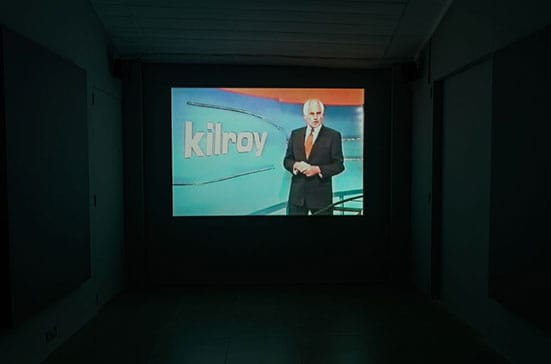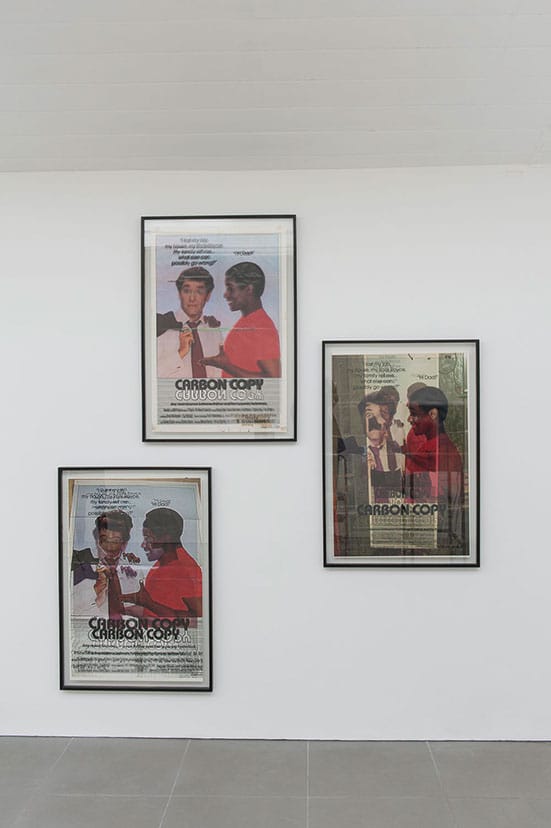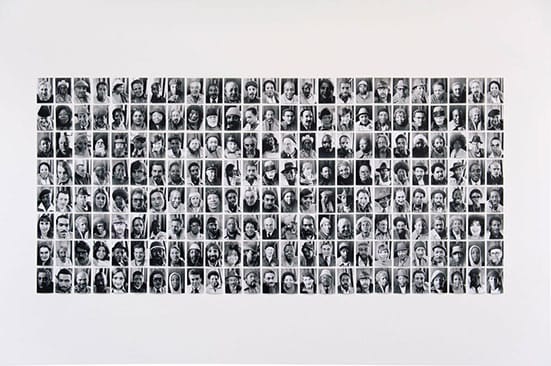14th March 2014 — 27th April 2014
Amongst the names of contributors to this exhibition one stands out from all the others and articulates something significant about the nature of the show as a whole. JGM1138 has been a YouTube account holder since 11 September 2011 and his/her collection of excerpts from the TV show Kilroy is one of the funniest and most disturbing things I have come across in a gallery for a very long time. Spliced together in rapid succession are a large number of the presenter's introductory taglines. Walking slowly towards the camera with an unfathomable sense of menace he asks a series of questions in the form of accusations:
'Your mother wants you to get divorced ... because she can't stand your husband?'
'You're forty ... and nobody wants you?'
'You're getting £37,000 a year in benefit ... to raise eight children?'
I find myself having to leave the darkened projection chamber before the loop is finished as Kilroy's lifesize figure appears to be getting closer and closer. I watch the whole thing later online at home, safe in the knowledge that he is now only six inches tall.
The works and materials gathered here at Cell Project Space represent a desire on the part of curator Morgan Quaintance to replicate that state which we inhabit when we drift online, browsing aimlessly or getting lost in an ever-expanding chasm of information and media. Despite the fact that much of what is online is indeed genuine or authentic there is a vast array of falsehoods and, in the words of Quaintance, 'questionable realities' to be discovered. The internet and truth have never been synonymous with one another and many of the works in this show are a testament to that fact.
Returning to the realm of 'real-world' names, John Lawrence's series Original Carbon Copy (2012) explores the notion of internet rumour in relation to the Hollywood star Denzel Washington. According to legend, the actor has endeavoured to purchase and destroy all existing copies of one of his early films in an attempt to erase it from cultural memory. As a counterpoint to this campaign, Lawrence has purchased posters for the film on eBay and printed the sellers' proof-of-condition JPEG on top of each one. The ghost-like duplications come to symbolise Washington's sense of being haunted by this production, each image slightly different from the next depending on the condition of the poster and the disparity between the original image and its digital counterpart.
From ghostly images of one kind we move on to the intentionally hammy apparitions in Michael Smith's surreal and absorbing film Secret Horror (1980). The central character, Mike, is accosted by ghosts at his home while he is doing the ironing and a bizarre sequence of events unfolds. In an early scene, one of the spooks irons the white sheet of another while Mike looks on in a state of confusion. Later on he dances to The Lion Sleeps Tonight while the ghosts shake a metal ceiling frame above his head. The gameshow music which accompanies much of the video adds an extra element of strangeness and I am reminded of Darren Aronofsky's Requiem for a Dream, albeit a very different kind of film.
In addition to these 'questionable realities', Quaintance is also interested in the notion of archival histories in relation to the internet. eBay merchant Gary Eastwood's collection of northern soul patches are presented here - the first time that they have been brought together offline and displayed in public. Sheldon Nadelman's Terminal Portraits (1973-82) depict the regulars that frequented his New York bar and these incredible faces tell many stories.
One of the show's great strengths is its juxtaposition of works by artists with those by contributors such as Eastwood and JGM1138. This device creates a dynamic dialogue between the various elements in the space and in many ways democratises the activities represented. This clashing of disparate realms is refreshing and leaves a lasting impression. In the text which accompanies this exhibition, Quaintance states that he 'wanted to create a space in which you forget yourself and the business of you being you disappears for a moment.' In this aim, through his very thoughtful curation, he has undoubtedly succeeded.
Alastair Levy
Cell Project Space
258 Cambridge Heath Road
London E2 9DA
http://cellprojects.org

Installation view, Pre Owned: Looks Good Man, Cell Project Space, 2014
Photo Damien Jaques

JGM1138
Killroy Loops (2008)
You Tube video clip
5 mins: 10secs (looped)
Photo Damien Jaques

John Lawrence,
Original Carbon Copy (2012– ongoing)
3 x (114.5 x 78.5 cm)
Photo Damien Jaques

Sheldon Nadelman
Terminal Portraits (1973 -82)
Part of a larger work
photographic inkjet print on paper
290 x 126cm
Photo Damien Jaques